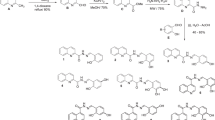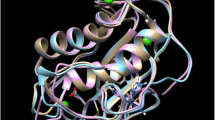Abstract
The most prominent feature of UV-induced photoaged skin is decreased type 1 procollagen. Increase of the TGF-β/Smad signaling through inhibition of the TβRI dephosphorylation by the GADD34–PP1c phosphatase complex represents a promising strategy for the increase in type 1 collagen production and prevention of UV-induced skin photoaging. In this study, the molecular docking and dynamics simulations, and pharmacophore modeling method were run to investigate a possible binding site as well as binding modes between apigenin, daidzein, asiaticoside, obovatol, and astragaloside IV and PP1c. Through docking study, the possible binding site for these phytochemicals was predicted as the hydrophobic (PP1–substrate binding) groove. The result indicates that PP1 is the significant target of these compounds. Moreover, the 20,000-ps MD simulations present that the binding locations and modes predicted by the docking have been slightly changed considering that the MD simulations proffer more reliable details upon the protein–ligand recognition. The MM-GBSA binding free energy calculations and pharmacophore modeling rationally identify that the highly hydrophobic surfaces/pockets at close proximity of the catalytic core are the most favorable binding locations of the herbal compounds, and that some experimental facts upon a possible mechanism of increase in collagen biosynthesis can be explained. The present study theoretically offers the reliable binding target of the herbal compounds, and therefore helps to understanding the action mechanism for natural small molecules that enhance collagen production.






Similar content being viewed by others
References
Park B, Hwang E, Seo SA, Cho JG, Yang JE, Yi TH (2018) Eucalyptus globulus extract protects against UVB-induced photoaging by enhancing collagen synthesis via regulation of TGF-beta/Smad signals and attenuation of AP-1. Arch Biochem Biophys 637:31–39. https://doi.org/10.1016/j.abb.2017.11.007
Gao W, Lin P, Hwang E, Wang Y, Yan Z, Ngo HTT, Yi TH (2018) Pterocarpus santalinus L. regulated ultraviolet b irradiation-induced procollagen reduction and matrix metalloproteinases expression through activation of TGF-beta/Smad and inhibition of the MAPK/AP-1 pathway in normal human dermal fibroblasts. Photochem Photobiol 94:139–149. https://doi.org/10.1111/php.12835
Quan T, He T, Kang S, Voorhees JJ, Fisher GJ (2004) Solar ultraviolet irradiation reduces collagen in photoaged human skin by blocking transforming growth factor-beta type II receptor/Smad signaling. Am J Pathol 165:741–751
He T, Quan T, Shao Y, Voorhees JJ, Fisher GJ (2014) Oxidative exposure impairs TGF-beta pathway via reduction of type II receptor and SMAD3 in human skin fibroblasts. Age (Dordr) 36:9623. https://doi.org/10.1007/s11357-014-9623-6
Xu P, Liu J, Derynck R (2012) Post-translational regulation of TGF-β receptor and Smad signaling. FEBS Lett 586:1871–1884. https://doi.org/10.1016/j.febslet.2012.05.010
Sun Z, Park SY, Hwang E, Park B, Seo SA, Cho JG, Zhang M, Yi TH (2016) Dietary Foeniculum vulgare Mill extract attenuated UVB irradiation-induced skin photoaging by activating of Nrf2 and inhibiting MAPK pathways. Phytomedicine 23:1273–1284. https://doi.org/10.1016/j.phymed.2016.06.008
Zhang Y, Wang J, Cheng X, Yi B, Zhang X, Li Q (2015) Apigenin induces dermal collagen synthesis via smad2/3 signaling pathway. Eur J Histochem 59:2467. https://doi.org/10.4081/ejh.2015.2467
Zhao D, Shi Y, Dang Y, Zhai Y, Ye X (2015) Daidzein stimulates collagen synthesis by activating the TGF-beta/smad signal pathway. Australas J Dermatol 56:e7–e14. https://doi.org/10.1111/ajd.12126
Lee J, Jung E, Kim Y, Park J, Park J, Hong S, Kim J, Hyun C, Kim YS, Park D (2006) Asiaticoside induces human collagen I synthesis through TGFbeta receptor I kinase (TbetaRI kinase)-independent Smad signaling. Planta Med 72:324–328. https://doi.org/10.1055/s-2005-916227
Choi MS, Yoo MS, Son DJ, Jung HY, Lee SH, Jung JK, Lee BC, Yun YP, Pyo HB, Hong JT (2007) Increase of collagen synthesis by obovatol through stimulation of the TGF-beta signaling and inhibition of matrix metalloproteinase in UVB-irradiated human fibroblast. J Dermatol Sci 46:127–137. https://doi.org/10.1016/j.jdermsci.2007.02.001
Chen B, Li R, Yan N, Chen G, Qian W, Jiang HL, Ji C, Bi ZG (2015) Astragaloside IV controls collagen reduction in photoaging skin by improving transforming growth factor-beta/Smad signaling suppression and inhibiting matrix metalloproteinase-1. Mol Med Rep 11:3344–3348. https://doi.org/10.3892/mmr.2015.3212
Bolton EE, Wang Y, Thiessen PA, Bryant SH (2008) Chap. 12 - PubChem: integrated platform of small molecules and biological activities. In: Wheeler RA, Spellmeyer DC (eds) Annual reports in computational chemistry, Elsevier, New York, pp. 217–241
Choy MS, Swingle M, D’Arcy B, Abney K, Rusin SF, Kettenbach AN, Page R, Honkanen RE, Peti W (2017) PP1:tautomycetin complex reveals a path toward the development of PP1-specific inhibitors. J Am Chem Soc 139:17703–17706. https://doi.org/10.1021/jacs.7b09368
Berman HM, Westbrook J, Feng Z, Gilliland G, Bhat TN, Weissig H, Shindyalov IN and Bourne PE (2000) The protein data bank. Nucleic Acids Res 28:235–242
Paul BK, Guchhait N (2011) A spectral deciphering of the binding interaction of an intramolecular charge transfer fluorescence probe with a cationic protein: thermodynamic analysis of the binding phenomenon combined with blind docking study. Photochem Photobiol Sci 10:980–991. https://doi.org/10.1039/C0PP00309C
Hamamura K, Chen A, Tanjung N, Takigawa S, Sudo A, Yokota H (2015) In vitro and in silico analysis of an inhibitory mechanism of osteoclastogenesis by salubrinal and guanabenz. Cell Signal 27:353–362. https://doi.org/10.1016/j.cellsig.2014.11.020
Duan Y, Wu C, Chowdhury S, Lee MC, Xiong G, Zhang W, Yang R, Cieplak P, Luo R, Lee T, Caldwell J, Wang J, Kollman P (2003) A point-charge force field for molecular mechanics simulations of proteins based on condensed-phase quantum mechanical calculations. J Comput Chem 24:1999–2012. https://doi.org/10.1002/jcc.10349
Joung IS, Cheatham TE IIIrd (2008) Determination of alkali and halide monovalent ion parameters for use in explicitly solvated biomolecular simulations. J Phys Chem B 112:9020–9041. https://doi.org/10.1021/jp8001614
Li P, Merz KM Jr (2014) Taking into account the ion-induced dipole interaction in the nonbonded model of ions. J Chem Theory Comput 10:289–297. https://doi.org/10.1021/ct400751u
Wongrattanakamon P, Nimmanpipug P, Sirithunyalug B, Chaiyana W, Jiranusornkul S (2018) Investigation of the skin anti-photoaging potential of Swertia chirayita secoiridoids through the AP-1/matrix metalloproteinase pathway by molecular modeling. Int J Pept Res Ther. https://doi.org/10.1007/s10989-018-9695-8
Humphrey W, Dalke A, Schulten K (1996) VMD: visual molecular dynamics. J Mol Graph 14:33–38, 27 – 8
Pettersen EF, Goddard TD, Huang CC, Couch GS, Greenblatt DM, Meng EC, Ferrin TE (2004) UCSF Chimera—a visualization system for exploratory research and analysis. J Comput Chem 25:1605–1612. https://doi.org/10.1002/jcc.20084
Roe DR, Cheatham TE IIIrd (2013) PTRAJ and CPPTRAJ: software for processing and analysis of molecular dynamics trajectory data. J Chem Theory Comput 9:3084–3095. https://doi.org/10.1021/ct400341p
Wolber G, Langer T (2005) LigandScout: 3-D pharmacophores derived from protein-bound ligands and their use as virtual screening filters. J Chem Inf Model 45:160–169. https://doi.org/10.1021/ci049885e
Liao SY, Mo GQ, Chen JC, Zheng KC (2014) Docking and molecular dynamics studies of the binding between Peloruside A and tubulin. J Enzyme Inhib Med Chem 29:702–709. https://doi.org/10.3109/14756366.2013.845816
Lee J, Jung E, Lee J, Huh S, Kim J, Park M, So J, Ham Y, Jung K, Hyun CG, Kim YS, Park D (2007) Panax ginseng induces human Type I collagen synthesis through activation of Smad signaling. J Ethnopharmacol 109:29–34. https://doi.org/10.1016/j.jep.2006.06.008
Acknowledgements
The authors would like to thank Inte:Ligand Software-Entwicklungs und Consulting GmbH for providing an academic free license for LigandScout 4.2.1.
Author information
Authors and Affiliations
Corresponding authors
Ethics declarations
Conflict of interest
Every author declares no conflict of interest.
Research involving in human and animal rights
This article does not contain any study with human or animal subjects performed by any of the authors.
Rights and permissions
About this article
Cite this article
Wongrattanakamon, P., Nimmanpipug, P., Sirithunyalug, B. et al. Molecular modeling investigation of the potential mechanism for phytochemical-induced skin collagen biosynthesis by inhibition of the protein phosphatase 1 holoenzyme. Mol Cell Biochem 454, 45–56 (2019). https://doi.org/10.1007/s11010-018-3451-4
Received:
Accepted:
Published:
Issue Date:
DOI: https://doi.org/10.1007/s11010-018-3451-4




